O instrumento atual digital
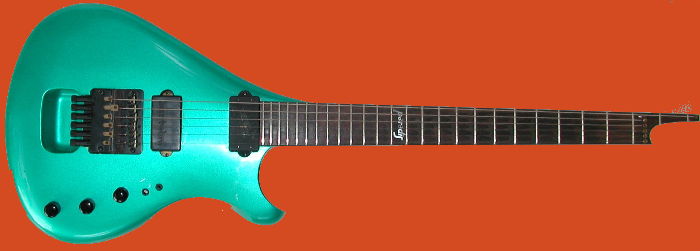 |
|
|---|---|
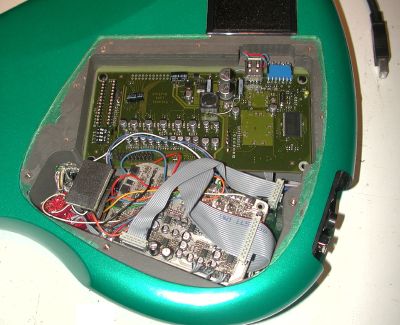 |
Paradis Elegy com FireWire
|
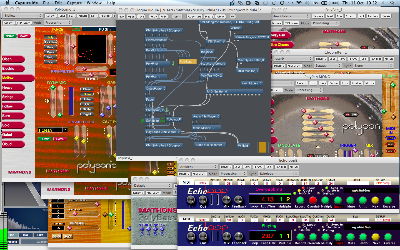 |
MacBook Pro with Mathons Poly and EchoLoop VST Plugins organized in Bidule
left click here to download full size screen note that the MIDI out of the Echoloop's go to the Wifi Midi, so all the leds, the state and the loop grow becomes visible on the pedal, which I find extremely important: |
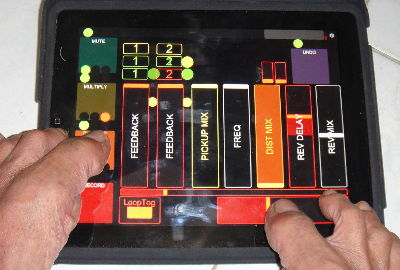 |
TouchOSC controlling 2 Echoloop and other parameters
botom right the volume swell thing, not quite as smoth as the good old pedal, but much smaller and does not need to be oiled. the heel can stay on the ground when the fader is not to long and horizontal, and turning the foot is at least as acurate as the classical "gas pedal" movement |
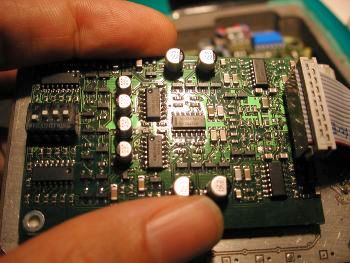 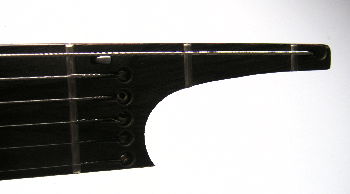 |
PolyBass
This has been my bass player since I created it in 1985! I made it a VST plugin as well, you can get it on request (if you have separate strings in your computer
the drop-D-head is Rolfs construction (and probably his idea as well?. |
O primeiro instrumento digital (2005)
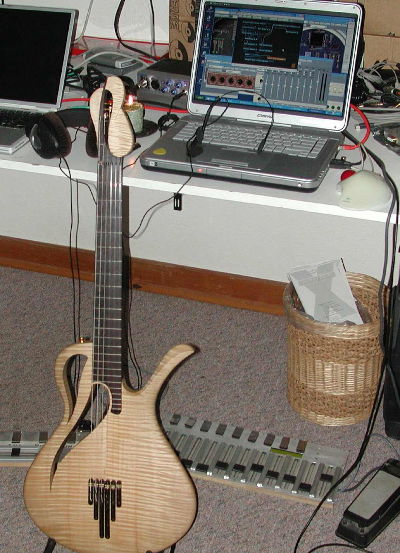 |
this was a hard start. left behind the laptop you see the Presonus FW interface. Its not really needed but helps to receive the headset microphone (which I could connect to the guitar but then realized its not practical because you ripp off the headset when you put the guitar down :-) I tried with a MacMini but had to sell it because it did not stop creating clicks and I learned the hard way that the cause was the shared video memory with this AMD Athlon64 PC it worked better, but I never really felt at home with assistance from BridgeCo who created the FW chip for the guitar and Presonus (and M-Audio and...) I got a driver that included both FW inputs. note that the pedal has a little brother which is empty and connects to the PC-1600 board in the big brother. it was great for BrotherSync jams
I do not know why I shoot the picture cutting the FW connector at the guitar... ... and left mothers trash bin in the picture hahaha |
|---|
O instrumento analogico (1985 - 2005)
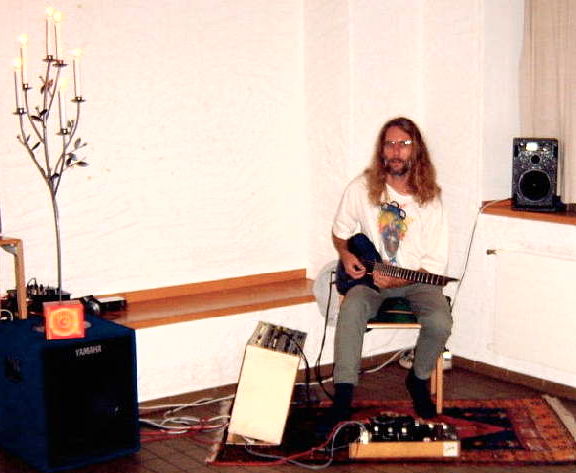 |
|
|---|---|
|
esta maquina me fez tocar feliz durante 20 anos, principalmente no Brasil, mas tb na Suica e nos EUA e ate uma tournee em GB e Suecia em 2003! the wooden box below was made by a carpenter friend in Weisslingen I sadly enough do not remember the name off
(as usual, I did pay for some of his work, but not all the time it took to figure out the construction which is never straigt forward for me :-) |
|
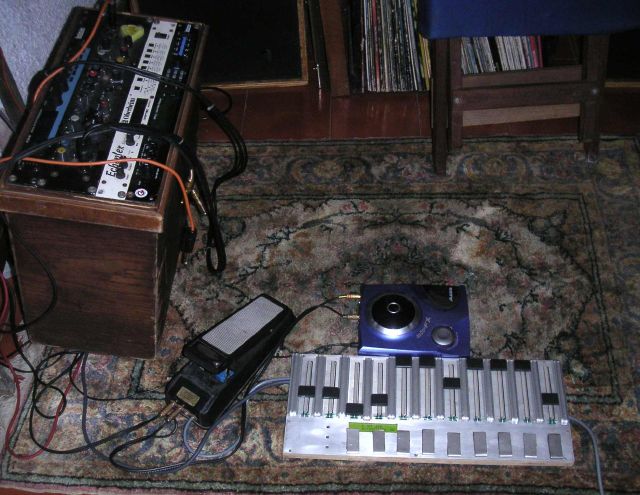 |
|
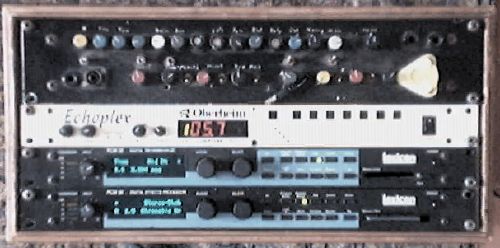 |
the top black unit is my own construction. it contains two PolyDistortions, a PolySubbass, some mono filtering and distortion I developped in the 70ies, a "speaker simulator" (a highcut, really) , a headphone amp and a Midi Controller (controlled by the pedal and controlling the Lexicons) |
meu caminho pelas ferramentas de Live Looping:
|
1985 |
Roland SDE 3000 with 3,5 seconds delay, rhythm tap (not instant!) and feedback pedal. |
|
1986 |
t.c. 2290 with 4 seconds delay, tap and feedback pedal.
|
|
1988 |
t.c. 2290 with 11 seconds delay, tap (t.c. called it "learn") and feedback pedal.
|
|
1989 |
Lexicon PCM42 heavily custimized with 20 seconds delay, tap, feedback pedal. |
|
1992 |
Paradis LOOP delay. Finally a Record function! Memory is not cheap, but we can buy the loop time we need. |
|
1994 |
Gibson Echoplex Digital Pro. Delay times are not a question any more. The only problem left is noise floor and mono. |
|
2003 |
Nephew Johnny first programmed a simple loop app for the Chameleon. Then we saw it was much easier to develop VST. |
|
2004 |
When the VST Plugin worked for me, partner Kim became afraid that I was stealing the LOOP software and forced me to stop. |
|
2007 |
Rick Walker calls me out of my isolation and I play the VST Plugin for the first time in public with Arild Anderson at the Y2k7 LiveLooping Festival! |
A contribuição do mecanico Mestre Moacir Massa
Seu Moacir trabalhou para Petrobraz e criou 13 filhos na casa enorme dele. Na garagem tem uma colecao impressioinante de ferramentas que ele renovou, fez e tal. Ele e uns dos filhos aparecem la todo dia e criam arte de madeira e metal e consertam geladeiras e carros e tal.
primeiro construiram esta cadeira para mim:
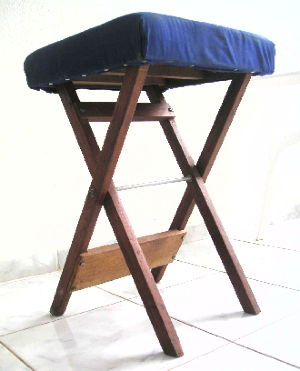 |
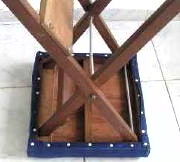 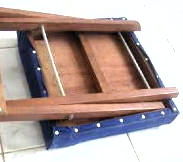 |
|---|---|
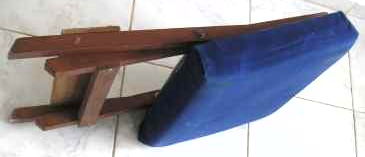 |
|
depois em volta de 2002 construimos este pedal, usando o PCB de um Peavey PC-1600. Ele so tem 25mm de altura - nao so pratico para transportar mas para operacao: o calcanhar fica no chão! 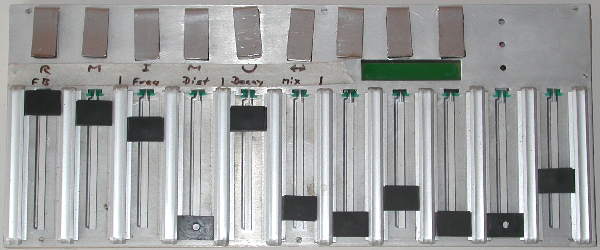 |
|
O primeiro sistema, feito de modulos Alpha 77 modificados:
I never bought a guitar amplifier. As soon as I started playing, I also started to assemble PCBs for Hermi Hogg, owner of Alpha 77, an incredible one man company that made all the sound mixers, amplifiers, cabinets, effects, multicores... for the well known swiss bands like Island, Tea,,, even Can came from germany for some special constructions. We built Chorus before that name existed for the effect, pitch shifters, and of course wahwah, distortion... and finally a digital delay and a discrete DSP... but the import equipment became cheaper and cheaper and Hermi finally started developing measuring systems for the animal hospital :-(
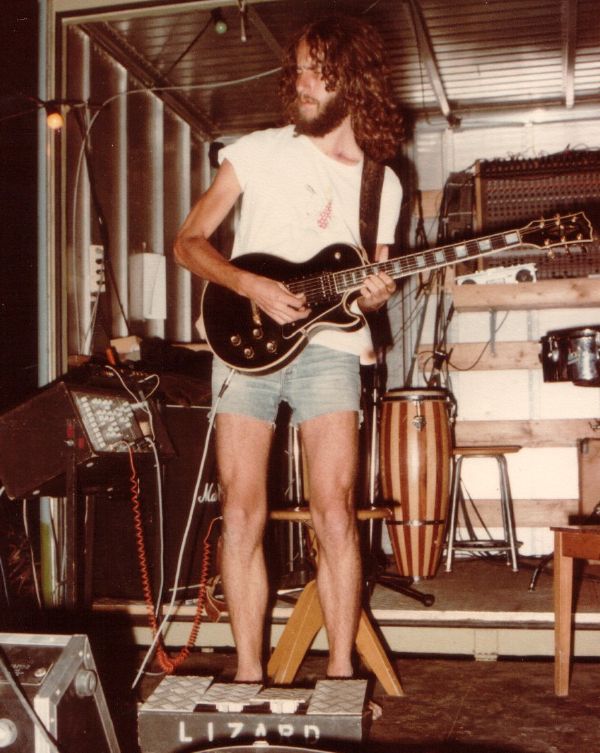 This Les Paul 1968 had a great sound. I equipped it with a Bartonlini Hex Pickup and a LEMO connector to the polyphonic distortion. But on this very tour in 1983 with Renato Cappellis first roling stage, the Mistral, the heavy wind of the south of france, broke its head for the second time and we did not fix it any more. It was to heavy anyway, bad for the back.
This Les Paul 1968 had a great sound. I equipped it with a Bartonlini Hex Pickup and a LEMO connector to the polyphonic distortion. But on this very tour in 1983 with Renato Cappellis first roling stage, the Mistral, the heavy wind of the south of france, broke its head for the second time and we did not fix it any more. It was to heavy anyway, bad for the back.
I also had a Kramer metal neck with a great Strat like sound. We later built the PolyDistortion into it and I finally sold it to Luiz Caldas who uses it still as he told me in about 2008.
You can see the modular amp on the left edge. The power amplifier sits in the back of it.
The huge pedal was also Hermi's construction.
More about this equipment here.


